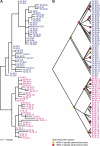Operon conservation and the evolution of trans-splicing in the phylum Nematoda
- PMID: 17121468
- PMCID: PMC1657053
- DOI: 10.1371/journal.pgen.0020198
Operon conservation and the evolution of trans-splicing in the phylum Nematoda
Abstract
The nematode Caenorhabditis elegans is unique among model animals in that many of its genes are cotranscribed as polycistronic pre-mRNAs from operons. The mechanism by which these operonic transcripts are resolved into mature mRNAs includes trans-splicing to a family of SL2-like spliced leader exons. SL2-like spliced leaders are distinct from SL1, the major spliced leader in C. elegans and other nematode species. We surveyed five additional nematode species, representing three of the five major clades of the phylum Nematoda, for the presence of operons and the use of trans-spliced leaders in resolution of polycistronic pre-mRNAs. Conserved operons were found in Pristionchus pacificus, Nippostrongylus brasiliensis, Strongyloides ratti, Brugia malayi, and Ascaris suum. In nematodes closely related to the rhabditine C. elegans, a related family of SL2-like spliced leaders is used for operonic transcript resolution. However, in the tylenchine S. ratti operonic transcripts are resolved using a family of spliced leaders related to SL1. Non-operonic genes in S. ratti may also receive these SL1 variants. In the spirurine nematodes B. malayi and A. suum operonic transcripts are resolved using SL1. Mapping these phenotypes onto the robust molecular phylogeny for the Nematoda suggests that operons evolved before SL2-like spliced leaders, which are an evolutionary invention of the rhabditine lineage.
Conflict of interest statement
Competing interests. The authors have declared that no competing interests exist.
Figures




References
-
- Bonen L. Trans-splicing of mRNA in plants, animals and protists. FASEB J. 1993;7:40–46. - PubMed
-
- Landfear SM, Wirth DF. Structure of mRNA encoded by tubulin genes in Leishmania enriettii . Mol Biochem Parasitol. 1985;15:61–82. - PubMed
-
- Kroiher M, Reidling JC, Steele RE. A gene whose major transcript encodes only the substrate-binding domain of a protein-tyrosine kinase. Gene. 2000;241:317–324. - PubMed
Publication types
MeSH terms
Substances
Associated data
- Actions
- Actions
- Actions
- Actions
- Actions
- Actions
- Actions
- Actions
- Actions
- Actions
- Actions
- Actions
- Actions
- Actions
- Actions
- Actions
- Actions
- Actions
- Actions
- Actions
- Actions
- Actions
- Actions
- Actions
- Actions
- Actions
- Actions
- Actions
- Actions
- Actions
- Actions
- Actions
- Actions
- Actions
- Actions
- Actions
- Actions
- Actions
- Actions
- Actions
- Actions
- Actions
- Actions
- Actions
- Actions
- Actions
- Actions
- Actions
- Actions
- Actions
- Actions
- Actions
- Actions
- Actions
- Actions
- Actions
- Actions
- Actions
- Actions
- Actions
- Actions
- Actions
- Actions
- Actions
- Actions
- Actions
- Actions
- Actions
- Actions
- Actions
- Actions
- Actions
- Actions
- Actions
- Actions
- Actions
- Actions
- Actions
- Actions
- Actions
- Actions
- Actions
- Actions
- Actions
- Actions
- Actions
- Actions
- Actions
- Actions
- Actions
- Actions
- Actions
- Actions
- Actions
- Actions
- Actions
- Actions
- Actions
- Actions
- Actions
- Actions
- Actions
- Actions
- Actions
- Actions
- Actions
- Actions
- Actions
- Actions
- Actions
- Actions
- Actions
- Actions
- Actions
- Actions
- Actions
- Actions
- Actions
- Actions
- Actions
- Actions
- Actions
- Actions
- Actions
- Actions
- Actions
- Actions
- Actions
- Actions
- Actions
- Actions
- Actions
- Actions
- Actions
- Actions
- Actions
- Actions
- Actions
- Actions
- Actions
- Actions
- Actions
- Actions
- Actions
- Actions
- Actions
- Actions
- Actions
- Actions
- Actions
- Actions
- Actions
- Actions
- Actions
- Actions
- Actions
- Actions
- Actions
- Actions
- Actions
- Actions
- Actions
- Actions
- Actions
- Actions
- Actions
- Actions
- Actions
- Actions
- Actions
- Actions
- Actions
- Actions
- Actions
Grants and funding
LinkOut - more resources
Full Text Sources
Other Literature Sources

